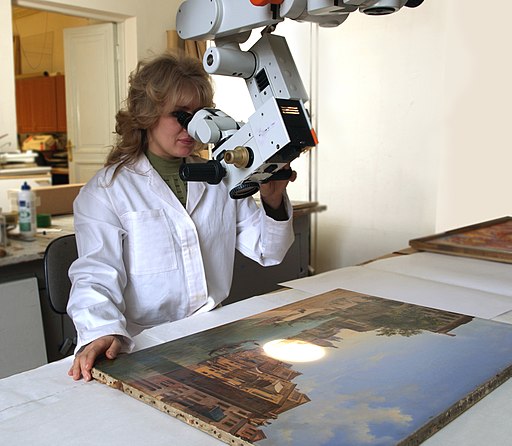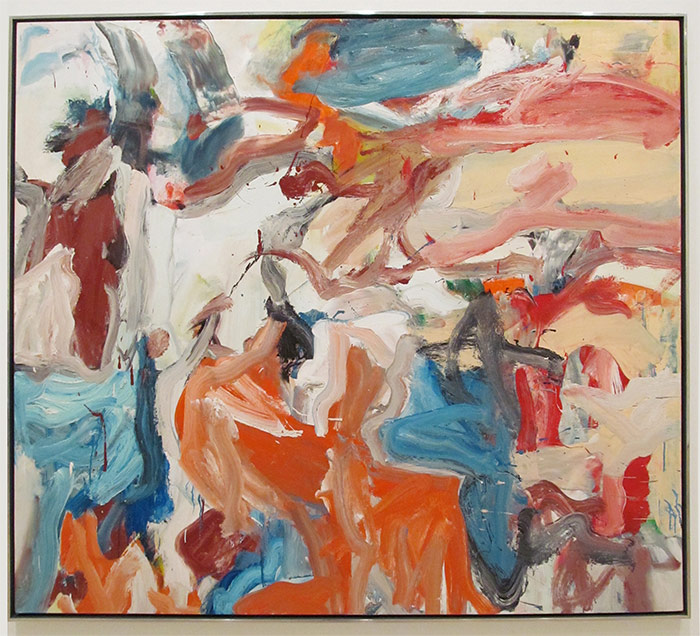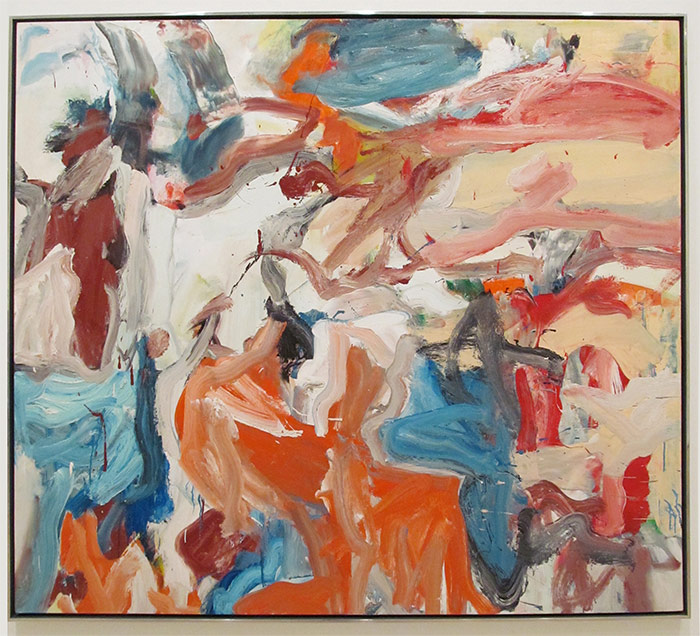Art collector’s are much more than art buyers. They are actually the ones who with museums dictate the art world trends. Fuelled by passion, consumerism, aesthetic passion and investment, art collectors’ power can be easily recognized and ‘categorised’ in different categories. So, what do art collectors look for?
Different collectors look for different things. As example a contemporary art collector won’t look after old masters artworks. A pop art art collector won’t research about conceptual art. Therefore, there are some mutual aspects that allow them to be art collectors. A desire to live with art, a passion for artists and their stories, art-world validation, art investment, among others.
What do art collectors look for?

Unlike simple art assemblages, art collections are meticulously well-planned projects. The art collectors submerge themselves deep into the subject of their interest and spend years and years looking for very particular art pieces that can bring the entire narrative together.So, what are the Collectors’ top motivations for purchasing art?
Aesthetics
All art collectors were once people who lived without art. If Rome wasn’t built in a day, no art collection can. The interesting fact is that majority of art collectors when they first started as outsiders they bought they first art piece in order to decorate their homes. The love to collect started after.
Another interesting fact is that more than 50% of art collectors who buy even to investment, cares deeply about aesthetics in order to purchase.
Art as an investment
Sometimes I get sad when artists complain that art is sold to investment purposes. I’m not saying that all art should be sold for the sake of profit, therefore the art market is a market, and should be taken care as such.
Not all art collectors buy art as an investment, therefore I don’t know any who said that an artwork appreciating in value overtime is not welcome. For whom is interested in art purely for investment purposes there are Art Investment Funds which are dedicated to the generation of a profitable return by acquiring and disposing of various works of art. Those funds are managed by a professional art investment management or art advisory firm who has expertise in the field. Having art as an investment asset in a portfolio doesn’t make it’s investor an art collector.
Passion for artists personalities and their stories
Artists are really interesting human beings, if they would not be “different” they would not be artists. They all have different personalities therefore there are mutual traces that make them artists. Art collectors are usually people more involved somehow in business, and even if not, knowing one or various artists is like getting into a different world. The way how artists see and perceive things are usually different, and art collectors like to understand why.
It’s interesting that some of the art collectors that I know wanted to be artists themselves. Once that achievement wasn’t possible, usually due to parents not approval, it’s like if they try to somehow get into the art world differently.
Art-world validation
A collector’s net worth is obviously correlated with their propensity to conspicuous consumption. Newbies to the market want and need a certain validation not just by other collectors but by museums, auction houses, collectors, artists and galleries. Some art collectors care about the art-world validation, while others prefer don’t even been seen in.
Higher status collectors reinforce status hierarchies through their privileged access to resources for displaying aesthetic confidence and their policing of lower status collectors’ claims. Performances of aesthetic confidence are both influenced by status and necessary for displaying status
The Different types of art Collectors
According with Artsy, there are ” Four Tribes of Art Collectors “. Let’s have a look.
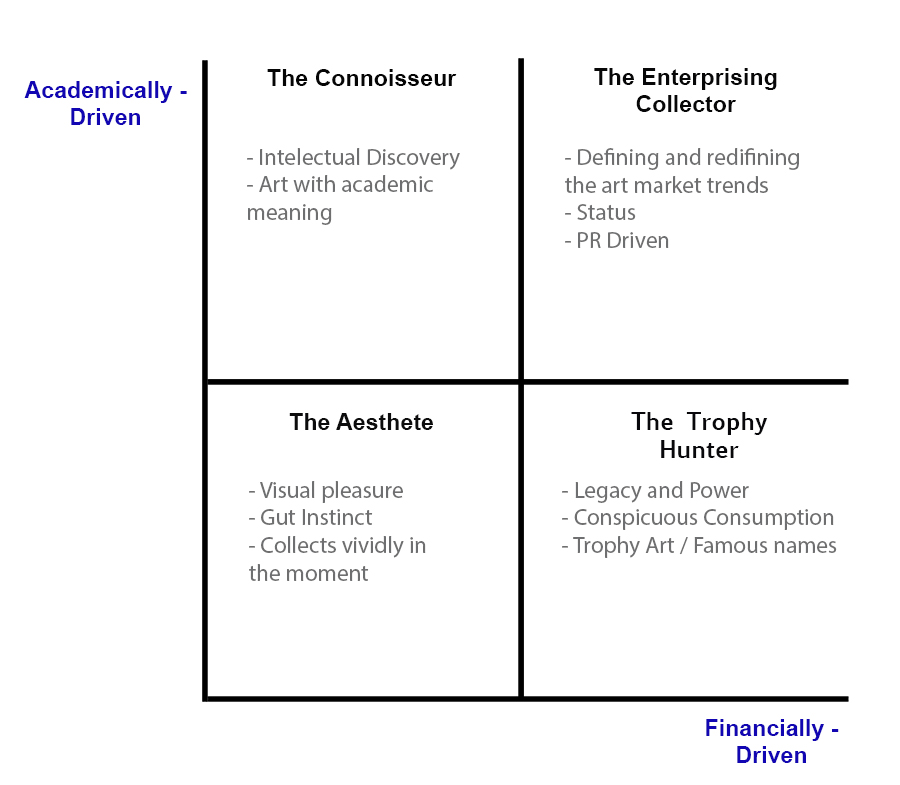
In order to understand what each collector is looking for, once collectors for same category look for similar things. Let’s start by The Trophy Hunter:
The Trophy Hunter

You know, Leonardo da Vinci’s Salvator Mundi (Savior of the World), sold for $450 million at Christies in 2017 to Saudi Prince Bader bin Abdullah …
For this “tribe” money is not a problem, for them is on what they spend their money that counts. They are rich enough to have more power over art trends than museums. This allows them to ignore the social structure of the art world.
Those collectors are the ones that can buy a Willem de Kooning for 62 millions or a Jeff Koons Rabbit for 91 millions without the need of thinking twice. Trophy Hunter Collectors are another level inside the art world. If this is the jungle those are the lions of the kingdom of art collecting.
For them Art delivers two types of pleasures: the joy of looking and the adrenaline of procuring. For Thorstein Veblen, those people are the ones who represent his theory of the ” conspicuous consumption “. Referring to consumers who buy expensive items to display wealth and income rather than to cover the real needs of the consumer.
When describing the art in their collection, they often don’t talk about the art itself but more about how they managed to buy the painting and how much they bought it for.
If you are not a famous artist already, whose paintings are worth millions, it is unlikely that you’re ever going to sell one of your artworks to a trophy hunter. Even if you are a successful artist, you may never come across this group as they predominantly purchase at auctions. The thrill of the chase is what drives them most.
What do they look for:
- Trophy Art
- Famous Names
The Aesthete
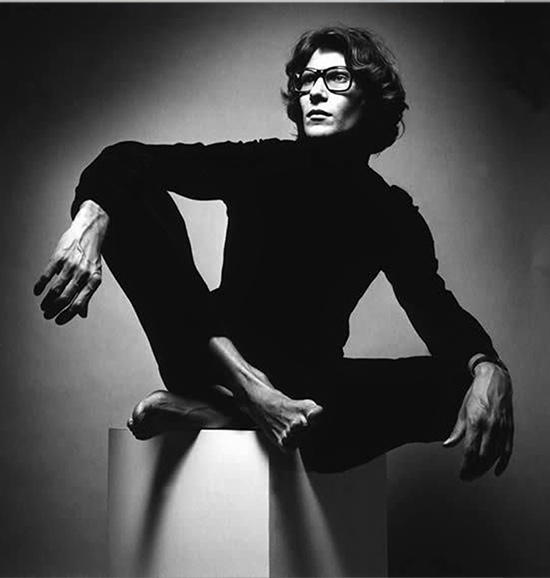
Introverted and not much self-conscious about the fact that they are art collectors, the Aesthete character is interesting. With some genius in this group, who left amazing art collections ( as example Yves Saint Laurent and his partner Pierre Bergé ) the Aesthete collectors are driven by a visceral response to the object. They’re often aware of what is fashionable, but almost never buy on the cutting edge of fashion.
Driven more by gut instinct, aesthetes collect vividly in the moment, but with a grand vision that unites disparate objects.
What do they look for:
- Aesthetic beauty
- Eccentric art
The Enterprising Collector

Gossip, lawsuits information, misinformation, fads, and rumors of the contemporary art market. Dynamic and real people make the Enterprising Collector tribe who is rather Extroverted and loves to have fun.
Enterprise collectors are wide open to the new and experimental. “Typically first-generation entrepreneurs, often from market-driven professions like finance and real estate, they view art as an asset class, but rarely as a pure investment (although most maintain lines of credit against their collections).” Artsy
These collectors are engaged in a kind of ethical combat to identify and elevate the art that will matter. Priced out of trophy hunting and too financially driven for the connoisseurs, their goal is to destabilize the market, in order to define and redefine art history through collecting.
While their ambition often exceeds their ability, a few—names such as Robert Scull, Charles Saatchi, and Guy Ullens—cut through the hype and help canonize the art of their time.
But despite an openness to new ideas, this is not an open society. Beneath the charm and flattery exists an intense competition for access: to top pictures, the right dinners, the most exclusive parties, the most prestigious museum boards. For this tribe, owning the right painting delivers a jolt of status more effectively than the efforts of the best PR firm.
What do they look for:
- New Talent
- Experimental artworks are welcome
- Extroverted gatherings
The Connoisseur
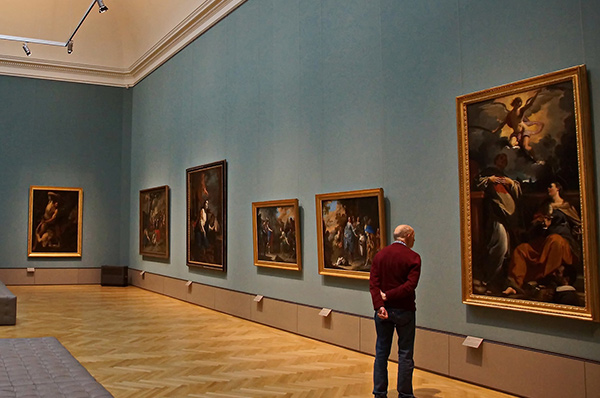
Connoisseurs are the academics of the art market. They buy methodically and rarely as an investment. They force us to stop and appreciate.
Independent, and unaffected by accepted taste , they are almost like the new avant-garde. They are, however, deeply invested in the opinions of a select few once expert opinion often matters more than fact. They socialize selectively, often excluding the art newbies who will eventually miss the subtle essentials.
I usually find those collectors in the old masters sector. They are introverted art collectors, some really wealthy therefore, they prefer to keep themselves behind the scenes.
What do they look for:
- Art with academic meaning
- Introverted art
Conclusion
- Different collectors look for different things
- A desire to live with art, a passion for artists and their stories, art-world validation and art investment are the top key factors drivin art collectors.
- There are different types of art collectors
- The Trophy Hunter looks for trophy art
- The Aesthete looks for something eccentric
- The Enterprising Collector cares more about new talent
- The Connoisseur prefers the intellectual side of the art



